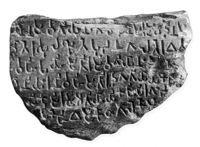Mahasthan Brahmi Inscription
Mahasthan Brahmi Inscription (c 3rd century BC) a fragmentary inscription in Brahmi characters, discovered at mahasthan in the Bogra district of Bangladesh, is the earliest epigraphic record in Bengal.
It is a small record of seven lines, incised on a circular stone, parts of which are broken. The inscription is palaeographically datable to the Maurya age (c 3rd century BC). The language of the inscription is Prakrit, but the influence of Magadhi is discernible. Different interpretations of the inscription have been given by scholars.

It records an order, issued by some ruler to the Mahamatra stationed at 'Pudanagala' (pundranagara> Mahasthana in Bangladesh) with a view to relieve the distress caused by some agency to the people called Samgvangiyas, who were settled in and about the town. The inscription speaks of four requisites viz tela (oil), duma (tree), dhanya (paddy) and two varieties of small coins called gandaka (ganda- a unit of calculation consisting of four kapardakas or cowries = one ganda) and Kakanyika (Kakamika-kapardaka or cowry). The storehouse or golaghar (Kothagala> Kosthagara) had to be filled up with these requisites as provisions against any emergency caused by water, fire and also the devastation of crops by parrots.
The historical importance of the record lies in the fact that it is the earliest evidence that suggests the authority of the Mauryas in the pundravardhana area. It provides us with the first definite evidence of urbanization in Bengal. The inscription throws light on the circulation of cowries as a medium of exchange in the area of Pundravardhana. It also alludes to the miseries of the people due to natural calamities and the relief measures adopted by the administration. [Sarita Khettry]
Bibliography DC Sircar, 'Mahasthan Fragmentary Stone Plaque Inscription', Select Inscriptions Bearing on Indian History and Civilisation, I, Calcutta, 1965; DR Bhandarkar, 'Mauryan Brahmi Inscription of Mahasthan', Epigraphia Indica, XXI, 83-91; BN Mukherjee, Coins and Currency Systems of Early Bengal, Calcutta, 2000.
